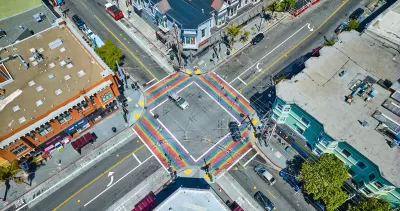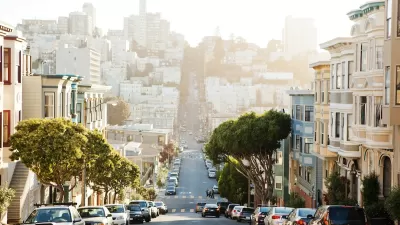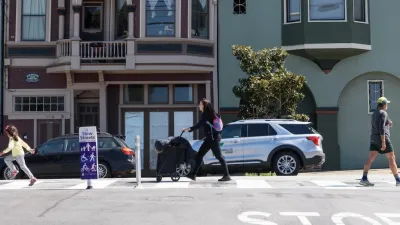Vehicles are prohibited from parking within 20 feet of a crosswalk as part of the city’s Vision Zero efforts to eliminate traffic deaths and make roads safer.

New parking rules went into effect in San Francisco this Monday, reports Amanda Bartlett in SFGate. The new rules ban parking within 20 feet of a crosswalk as part of a safety strategy known as ‘daylighting,’ which improves visibility for both drivers and pedestrians by removing obstructions from intersections. According to WalkSF, daylighting can reduce crashes by as much as 30 percent.
San Francisco drivers will receive a written warning if they violate the law. “The warning period serves as a way to raise awareness of the policy in San Francisco before SFMTA starts issuing $40 citations come Jan. 1, 2025,” Bartlett explains.
However, drivers will likely have to guess where the 20-foot zone ends at many intersections. “San Francisco does not have resources to paint every crosswalk corner approaching red, and a program that relies only on paint would require repainting every corner approximately every 5 years or so, thus it would also require significant maintenance resources going forward,” said an SFMTA spokesperson in April. The city has painted curbs at “many busy or high injury intersections.”
The initiative is expected to remove up to 5 percent of the city’s on-street parking spaces. Safety advocates say this is a worthwhile tradeoff, particularly in light of news that 2024 could be the deadliest year for road users since the city pledged to implement Vision Zero in 2014.
FULL STORY: A major change is coming to San Francisco's parking rules

Trump Administration Could Effectively End Housing Voucher Program
Federal officials are eyeing major cuts to the Section 8 program that helps millions of low-income households pay rent.

Planetizen Federal Action Tracker
A weekly monitor of how Trump’s orders and actions are impacting planners and planning in America.

Ken Jennings Launches Transit Web Series
The Jeopardy champ wants you to ride public transit.

Crime Continues to Drop on Philly, San Francisco Transit Systems
SEPTA and BART both saw significant declines in violent crime in the first quarter of 2025.

How South LA Green Spaces Power Community Health and Hope
Green spaces like South L.A. Wetlands Park are helping South Los Angeles residents promote healthy lifestyles, build community, and advocate for improvements that reflect local needs in historically underserved neighborhoods.

Sacramento Plans ‘Quick-Build’ Road Safety Projects
The city wants to accelerate small-scale safety improvements that use low-cost equipment to make an impact at dangerous intersections.
Urban Design for Planners 1: Software Tools
This six-course series explores essential urban design concepts using open source software and equips planners with the tools they need to participate fully in the urban design process.
Planning for Universal Design
Learn the tools for implementing Universal Design in planning regulations.
Heyer Gruel & Associates PA
Ada County Highway District
Institute for Housing and Urban Development Studies (IHS)
City of Grandview
Harvard GSD Executive Education
Toledo-Lucas County Plan Commissions
Salt Lake City
NYU Wagner Graduate School of Public Service





























